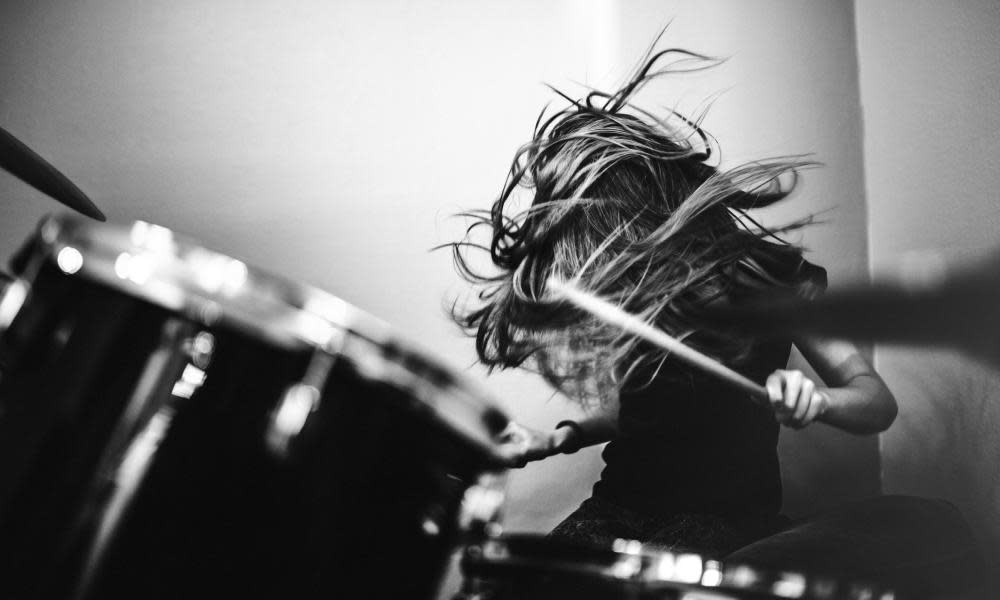My year in music: HMLTD and Jens Lekman, by way of Bonnie Tyler and AC/DC

In the early months of the year, when the days are grey and the nights dark, I oscillate musically. On the one hand, I gravitate towards music that seems hibernatory – on the other, I crave light and warmth. In January and February 2017, I spent a lot of time with Jens Lekman’s Life Will See You Now, an album that managed to combine the light and the dark. On Evening Prayer – a disco track that makes your feet shuffle involuntarily – he contemplates mortality, on what must be the most joyous song about a tumour ever written. “How I prayed that I could stop the pain,” he tells us, “when the pain needed more than ibuprofen.”
Many of us turn to music to reflect our moods, and I’m no exception. I went through a massive change in my life in the spring, leaving the Guardian after 16 years to turn freelance. Like any change, it was nerve-racking – but it filled me with a sense of adventure, and two new groups reflected that. The Australian band Confidence Man put out a single called Bubblegum that thrilled me: cheap and guileless and full of joy (a live show at the Social in London had me smiling for days afterwards); and a London band called HMLTD, six Bowie wannabes with a flair for the theatrical, had the same effect.
One thing about being a writer for hire, rather than an editor, is that I no longer sift through piles of albums looking for the ones that need to be written about in quite the same way. I spend more time paying close attention to the artists I’m going to be writing about, which this summer took the form of immersing myself in the music of my early teens: metal and hard rock. I listened non-stop to Guns N’ Roses’ Appetite for Destruction in preparation for writing about their show at the Olympic stadium in June. It still sounds extraordinary: a group whose danger seemed real and present in the grooves, rather than illusory. It’s wildly unpleasant in places, of course, but when Slash and Izzy Stradlin’s guitars reach maximum velocity, and Axl Rose’s feral yowl hits the high notes, the unpleasantness becomes part of the thrill.
My kids are growing up now, and this summer seemed likely to be our last family holiday. So we headed off to the west coast of the US – me with a bunch of new releases to listen to in our unfeasibly large rental car, plus a few oldies for the rest of the family. I barely got near the new stuff because my 17-year-old daughter insisted, repeatedly, that we put The 80s Part One and The 80s Part Two on repeat. That’s an awful lot of power ballads, new romanticism and pop dance hits. It felt slightly incongruous to slam on the brakes to avoid hitting a black bear ambling across the road, just as Bonnie Tyler explained that once upon a time there was light in her life, but now there’s only love in the dark. I wasn’t a huge fan of much of this at the time, but to be part of a family singing along to music to pass the time on a long journey is a wonderful feeling.
Then it was back to work, back to working my way through albums to review, and two stood out this autumn. Margo Price’s second album, All American Made, is country how it used to be, with lyrics that very much aren’t how they used to be – among other things, there’s one song about the gender pay gap. But All American Made isn’t an earnest piece of preaching: it’s sharp, funny and piercing. The live show in London this November was one of my highlights of the year. Price was no surprise to me, but Anna Ternheim was. She’s a pop star already in Sweden, but her album All the Way to Rio was the first I’ve heard of her, and I was knocked sideways by its beauty and melancholy, which hit so many of my musical sweet spots – guitar arpeggios like early REM, breathy and affectless vocals, a sense of mystery. It’s delicious.
But winter brought the colossally sad news of the death of Malcolm Young, the founder and rhythm guitarist of AC/DC. They were the first band I ever loved, and Powerage was the first album I ever bought. In the wake of his death, I returned to it – yet again. And as I always do, I thought: how could any band ever have managed to sound so impossibly exciting?
Any musical year is going to be one of contradiction – singer-songwriters bumping up to dance hits, themselves elbowed out of the way by rock’n’roll bands. And in an age in which unlimited streaming opens the door to old and new tunes simultaneously, music throws up incredible surprises. My most surprising musical event of the year was my grime-loving 14-year-old son announcing over dinner that he wanted to listen to this “funny old dude” he had heard, which turned out to be poet Ivor Cutler. This past year was one in which the music I listened to was more constantly eclectic than ever before – from Franco-Arab dance to obscure 70s proto-metal to gleaming pop-country, via the inevitable Despacito. It was a cauldron of music from which certain elements clawed their way into dominating my tastebuds, some new, some old, some loud, some quiet. It was, as a famous blue-eyed singer once put it, a very good year.
Listen to your favourite music in 2017 on Spotify

 Yahoo News
Yahoo News 
